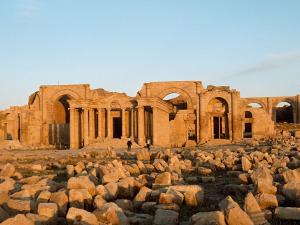Short Description
Over the past weeks and months, the world has been witness to the tragic destruction of historical sites across Iraq
As illustrated in a recent article by Gerard Russell, there appears to be a growing feeling that ISIS is only fulfilling its ‘’Islamic’’ obligation through its destructive rampage. The justification for this view is often found in the edicts of ultra-conservative Islamist scholars who go so far as to call for all ‘’non-Islamic’’ symbols to be destroyed.
However, how true is this extreme position to Islam’s history and teachings?
Islam, the world’s second largest religion, was established in 610 CE. Over the 1,400 years that followed, the Muslim community was ruled over by dozens of dynasties and rulers, some good, some despotic and most indifferent. However, Muslims consider the leadership of the Prophet Muhammad and his first four successors (the Rashidun caliphs) to have excelled in justice and piety – symbols of the most pristine representation of the teachings of Islam.
For example, following two decades of heavy persecution, 10,000 Muslims are said to have been led by the Prophet Muhammad into Mecca, in what has come to be known as the ‘bloodless victory’. With very few exceptions, the hundreds, if not thousands of Meccans who had persecuted, often viciously, the Prophet and his community were met with compassion and no revenge. The Orientalist Stanley Lane-Poole described the scene as follows:
“The day of Muhammad’s greatest triumph over his enemies was also the day of his grandest victory over himself. He freely forgave the Quraysh all the years of sorrow and cruel scorn to which they had inflicted him, and gave an amnesty to the whole population of Mecca.”
Critics often point to reports that the Prophet, shortly after the victory of Mecca, entered the Ka’ba, the large black object situated in Mecca to which all Muslims direct their prayers, and had the idols therein destroyed. And this much is true.
According to Muslim belief, the Ka’ba was considered a monotheistic symbol that had emerged from the Judaic tradition. It was felt that the Meccans had taken charge of the Ka’ba and abused its monotheistic provenance. Now that Mecca was again under monotheistic rule, the removal of the idols was to restore the Ka’ba to its original, Abrahamic purpose.
However, critics often ignore what the Prophet Muhammad did not do; for example, he did not enter people’s homes and destroy their idols or prohibit them from pagan practice and belief; neither did not have his followers scour Arabia in order to remove all remnants of paganism or idol worship. A far cry from the recent scenes of destruction and intolerance in Iraq.
The second caliph and successor to the Prophet Muhammad was ‘Umar b. al-Khattab, known for being a devout Muslim and firm in upholding the Islamic teachings. As anyone who has ventured down to Cairo’s Giza suburb will have seen, when Egypt came under Muslim rule, during Umar’s reign, the Muslims did not tie ropes around the Sphinx and pull it down or destroy Coptic monasteries.
When Iraq soon followed in Cairo’s footsteps, Muslim rulers made use of its ancient cities as cultural centers rather than to destroy them. And when Jerusalem came under Muslim rule, Umar had the Temple Mount restored as it had become, under Byzantine rule, a site of ruins and a rubbish dump. Had the teachings of the Qur’an and practice of the Prophet Muhammad demanded the destruction of such sites, then they would have been destroyed, without exception.
So while our attention is rightly focused on the recent indefensible destruction of the ancient cities of Hatra and Nimrod by ISIS, it should not be lost on us that what ISIS destroyed in hours stood intact for almost 1,400 years under Muslim rule.
Moreover, it is important not to fall into the trap of thinking that ISIS’ attacks have been limited to non-Muslim sites and artifacts – or, as it were, to the symbols of the ‘kuffar‘ (unbelievers). This is simply not the reality. Last month ISIS also destroyed a prominent sunni Ottoman Mosque in Mosul; a city that has also seen the destruction of sufi shrines, shi’a mosques, and a seventh century church that dates back to the very beginnings of Islam.
Likewise, Muslim leaders are far from silent on this matter.
source:
http://www.islamicnewsdaily.com/islamic-news/islam-history-protecting-civilisation-destroying/






![نصيحتي لك: اذكر الله [1 / 12] نصيحتي لك: اذكر الله [1 / 12]](https://300035.dotdothktrade.tech/images/upload/content_thumbs/1913613138ragheb-al-serjany-videos.jpg)


Comments
Send your comment